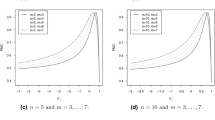Abstract
Most technology companies are experiencing highly volatile markets with increasingly short product life cycles due to rapid technological innovation and market competition. Current supply-demand planning systems remain ineffective in capturing short life-cycle nature of the products and high volatility in the markets. In this study, we propose an alternative demand-characterization approach that models life-cycle demand projections and incorporates advanced demand signals from leading-indicator products through a Bayesian update. The proposed approach describes life-cycle demand in scenarios and provides a means to reducing the variability in demand scenarios via leading-indicator products. Computational testing on real-world data sets from three semiconductor manufacturing companies suggests that the proposed approach is effective in capturing the life-cycle patterns of the products and the early demand signals and is capable of reducing the uncertainty in the demand forecasts by more than 20%.
Similar content being viewed by others
References
Aytac, B., & Wu, S. D. (2010). Modelling high-tech product life cycles with short-term demand information: a case study (Working Paper 10W-002). Lehigh University.
Banerjee, A., & Marcellino, M. (2006). Are there any reliable leading indicators for US inflation and GDP growth?. International Journal of Forecasting, 22(1), 137–151.
Bass, F. M. (1969). A new product growth for model consumer durables. Management Science, 15(5), 215–226.
Bates, J. M., & Granger, W. J. (1969). The combination of forecasts. Operational Research Quarterly, 20(4), 451–468.
Bonser, J. S., & Wu, S. D. (2001). Procurement planning to maintain both short-term adaptiveness and long-term perspective. Management Science, 47(6), 769–786.
Chatfield, C. (1993). Calculating interval forecasts. Journal of Business and Economic Statistics, 11(2), 121–133.
Chen, C. H. (1996). A lower bound for the correct subset-selection probability and its application to discrete-event system simulations. IEEE Transactions on Automatic Control, 41(8), 1227–1231.
Chen, C. H., Wu, S. D., & Dai, L. (1999). Ordinal comparison of heuristic algorithms using stochastic optimization. IEEE Transactions on Robotics and Automation, 15(1), 44–56.
Chen, H. C., Chen, C. H., & Yucesan, E. (2000). Computing efforts allocation for ordinal optimization and discrete event simulation. IEEE Transactions on Automatic Control, 45(5), 960–964.
Dickinson, J. P. (1973). Some statistical results in the combination of forecasts. Operational Research Quarterly, 24(2), 253–260.
Eppen, G. D., & Iyer, A. V. (1997). Improved fashion buying with Bayesian updates. Operations Research, 45(6), 805–819.
Fisher, R., & Raman, A. (1996). Reducing the cost of demand uncertainty through accurate response to early sales. Operations Research, 44(1), 87–99.
Hause, J. C. (1971). Spectral analysis and the detection of lead-lag relations. The American Economic Review, 61(1), 213–217.
Heeler, R. M., & Hustad, T. P. (1980). Problems in predicting new product growth for consumer durables. Management Science, 26(10), 1007–1020.
Islam, T., Fiebig, D. G., & Meade, N. (2002). Modelling multinational telecommunications demand with limited data. International Journal of Forecasting, 18, 605–624.
Kim, H. (2003). A Bayesian analysis on the effect of multiple supply options in a quick response environment. Naval Research Logistics, 50, 937–952.
Kurawarwala, A. A., & Matsuo, H. (1998). Product growth models for medium-term forecasting of short life cycle products. Technological Forecasting and Social Change, 57, 169–196.
Mahajan, V., & Sharma, S. (1986). A simple algebraic estimation procedure for innovation diffusion models of new product acceptance. Technological Forecasting and Social Change, 30, 331–345.
Mahajan, V., Muller, E., & Bass, F. (1990). New product diffusion models in marketing: a review and directions for future research. Journal of Marketing, 54, 1–26.
McKay, M. D., Beckman, R. J., & Conover, W. J. (1979). A comparison of three methods for selecting values of input variables in the analysis of output from a computer code. Technometrics, 21, 239–244.
Meade, N. (1985). Forecasting using growth curves—an adaptive approach. Journal of the Operational Research Society, 36(12), 1103–1115.
Meade, N., & Islam, T. (1995). Prediction intervals for growth curve forecasts. Journal of Forecasting, 14, 413–430.
Meade, N., & Islam, T. (1998). Technological forecasting—model selection, model stability, and combining models. Management Science, 44(8), 1115–1130.
Meade, N., & Islam, T. (2006). Modelling and forecasting the diffusion of innovation—a 25-year review. International Journal of Forecasting, 22(3), 519–545.
Meixell, M. J., & Wu, S. (2001). Scenario analysis of demand in a technology market using leading indicators. IEEE Transactions on Semiconductor Manufacturing, 14, 65–75.
Press, S. J. (2003). Subjective and objective Bayesian statistics: principles, models, and applications. New York: Wiley.
Quinn, T., & Mawdsley, A. (1996). Forecasting Irish inflation: a composite leading indicator (Technical report). Economic Analysis, Research and Publications Department. Central Bank of Ireland.
Schmittlein, D., & Mahajan, V. (1982). Maximum likelihood estimation for an innovation diffusion model of new product acceptance. Marketing Science, 1(1), 57–78.
Srinivasan, V., & Mason, C. H. (1986). Nonlinear least squares estimation of new product diffusion models. Marketing Science, 5(2), 169–178.
Sultan, F., Farley, J. U., & Lehmann, D. R. (1990). A meta-analysis of diffusion models. Journal of Marketing Research, 27, 70–77.
Talukdar, D., Sudhir, K., & Ainslie, A. (2002). Investigating new product diffusion across products and countries. Marketing Science, 21(1), 97–114.
Tigert, D., & Farivar, B. (1981). The Bass new product growth model: a sensitivity analysis for a high technology product. Journal of Marketing, 45, 81–90.
Timmermann, A. (2006). Handbook of economic forecasting, Chap.: Forecast combination. Amsterdam: North-Holland, p.p. 135–196.
Wu, S. D., Aytac, B., Berger, R. T., & Armbruster, C. A. (2006). Managing short life-cycle technology products for agere systems. Interfaces, 36, 234–247.
Zhu, K., & Thonemann, U. (2004). An adaptive forecasting algorithm and inventory policy for products with short life cycles. Naval Research Logistics, 51(5), 633–653.
Author information
Authors and Affiliations
Corresponding author
Rights and permissions
About this article
Cite this article
Aytac, B., Wu, S.D. Characterization of demand for short life-cycle technology products. Ann Oper Res 203, 255–277 (2013). https://doi.org/10.1007/s10479-010-0771-5
Published:
Issue Date:
DOI: https://doi.org/10.1007/s10479-010-0771-5




